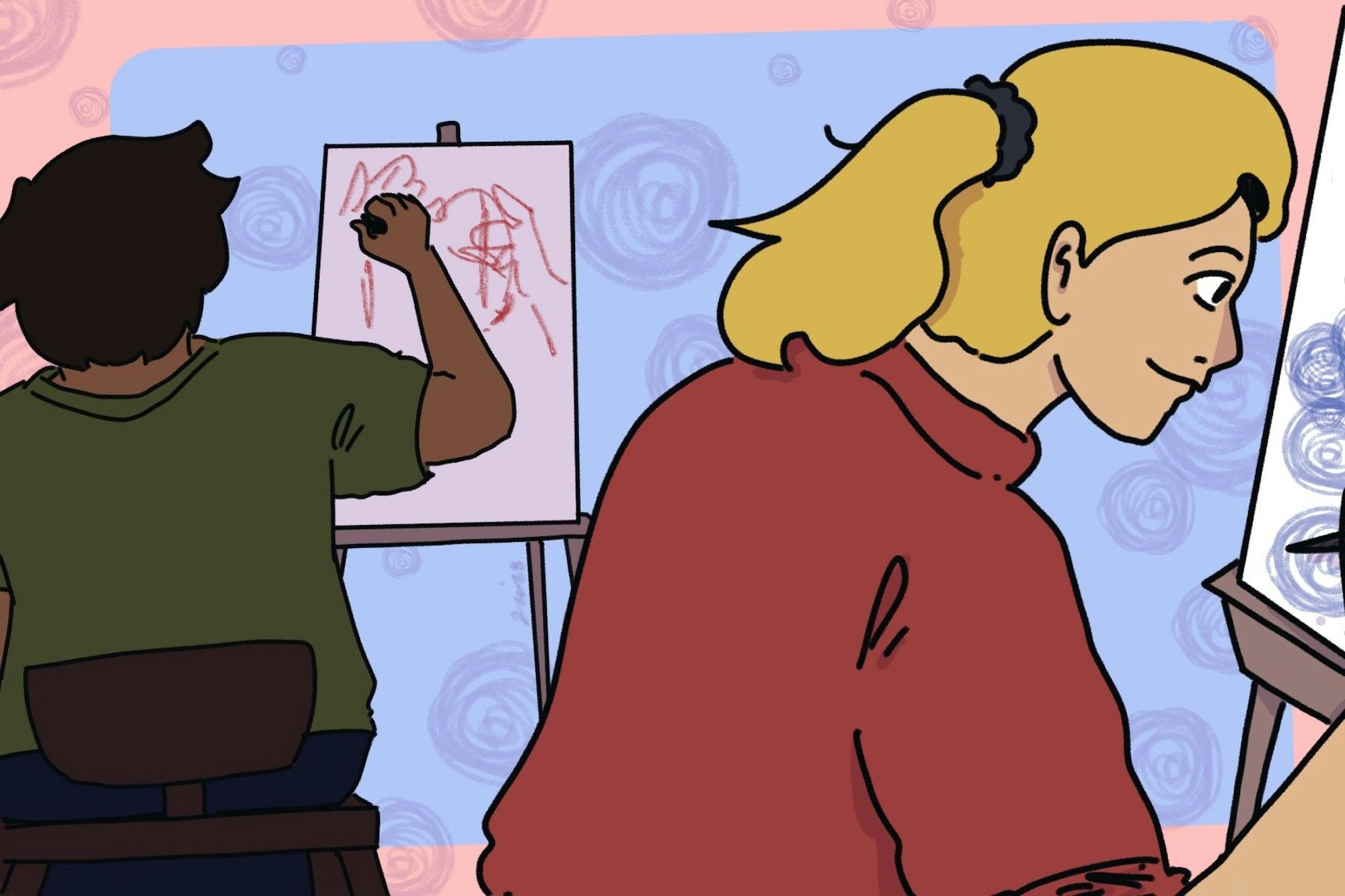As seniors inch closer to graduation, spring term is undoubtedly a time of relaxation and nostalgia, with a healthy dose of partying sprinkled on top. However, not all seniors can give into the mayhem that is their last spring in the woods. In fact, the sixteen seniors who are majoring in studio art are amid a critical stage of their Dartmouth experience, as they gear up for their culminating project — the studio art department Senior Majors Exhibition.
The show, which will take place in early May, will display various pieces that the studio art majors have worked on throughout the year. The pieces featured in the show will be hand-picked by the studio art department’s faculty. Landon Armstrong ’23, Izzy Hillman ’23 and Mckenna Kellner ’23 are three seniors currently preparing for the showcase.
Kellner said her work includes both painting and multi-textile pieces.
“My work [this year] has been making various paintings and fabric pieces about houses and floor plans and elevations, as well as working with textiles in new ways,” she said.
For her last year in Dartmouth’s studio, Hillman said she has “been focusing on Catholic and religious art in general in relation to my Jewish identity.” She explained that her work has featured a lot of “bright colors, nontraditional materials and gestural abstractions that play with the conventions of religious work.”
The studio art major at Dartmouth consists of ten courses, which are offered in six different concentrations: architecture, drawing, painting, photography, printmaking and sculpture. Armstrong, who is specializing in printmaking, focused his senior pieces on “print-making techniques, which entails book covers, posters and stuff and incorporating it into an interactive wall.”
It’s no secret that Dartmouth is primarily known for its government and economics departments, as they are traditionally some of the most popular areas of study. However, this often causes many students to overlook more niche subjects, such as studio art.
Hillman said she has observed that many of her peers seem surprised at the amount of work each art course requires.
“One time, this kid in my class commented, ‘Wow! This is just as much work as my economics class!’” Hillman said, adding, “Art is a different type of work, but it’s still hard work…I think some people can’t get out of the mindset that hard work is not limited to a problem set or something like that.”
Perhaps contrary to popular belief, the setting of rural New Hampshire lends itself well to an artistic mind, despite not being a creative metropolis, Hillman added.
“Of course there aren’t the same institutions like museums or galleries [in New Hampshire] to the extent that there would be in a big city setting,” she said. “But I’ve always felt like Dartmouth is a really awesome environment for art because of how little other things there are to do. You are sort of forced to work and look around and draw inspiration from new sources.”
The Hood Museum of Art, galleries and studios in the Upper Valley and the Dartmouth studio art faculty, all of whom are working artists, offer so much to student’s art experience, according to Hillman.
All three seniors said that while the studio art department is small, it has many perks because of its size: the ability to form close relationships with professors, intimate class sizes and a tight-knit community of students who consistently work in collaborative settings. Armstrong, Kellner and Hillman each cited at least one studio art professor that they felt was an integral source of support and encouragement to them while pursuing their major.
“The best thing about Dartmouth is that it’s not an arts school!” Kellner said. “The art department has tons of money and resources and only sixteen art majors, so everyone gets a lot of individualized attention from these amazing, passionate professors who really encourage you to pursue it.”
Additionally, Armstrong commented on the fact that studying studio art at a liberal arts college can be advantageous to students in the long-run. He explained that many visiting professors or critics have emphasized that while studio artists at Dartmouth may not have technical abilities on par with artists attending a traditional art school, they often produce higher-concept work because they continuously exercise critical thought in a variety of different subjects due to their liberal arts education.
Many studio art majors even choose to double major at Dartmouth.Armstrong, who is a QSS and studio art double-major, said that “with studio art at Dartmouth, you can easily pursue two different passions and have your varied interests lend themselves to one another, which I have felt generates a more interesting and multi-dimensional group of artists.”
Hillman also chose to double-major in psychology and studio art.
“I’ve found doing both psychology and studio art to be pretty intuitive and complementary,” she said. “I don’t make art about psychology, but they inform one another, in that I’m always really interested in the human analysis side of things.”
In their senior year, studio art majors receive new privileges, including their own individual studio spaces.
“I’ve had so many positive memories of studio art this term in particular, mainly because we seniors have had a lot of late nights in our own studio space, where we can all work on our individual projects, walk around to see what others are up to and can bounce ideas off each other,” Armstrong said.
Hillman echoed Armstrong’s sentiment, saying how much she appreciates the studio art community.
“Just late last night I had to hang up this huge thing, and all of the other seniors in the studio helped me get a ladder and spotted me and everything,” she said.
Kellner advised students who are potential studio art majors to jump in and go for it.
“At the end of the day, I think with studio art you just must be willing to take yourself seriously, so that others will take you seriously,” she said. “You can get out of it what you put in.”




